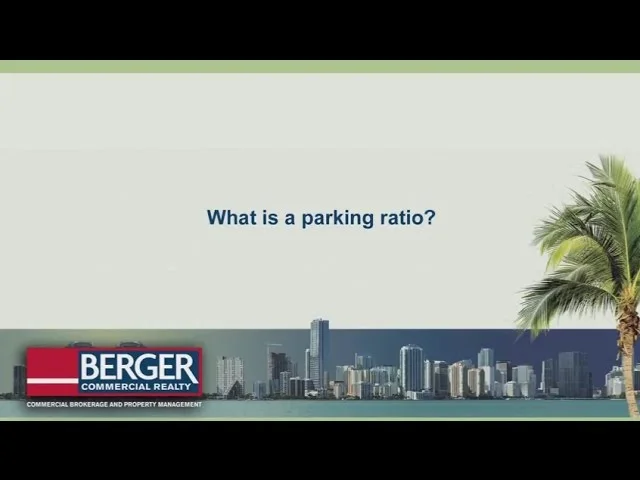A phase 1 is an environmental site assessment that identifies potential or existing environmental contamination liabilities.
Archives: Berger Bites
Holds Berger Bites on the website
What is a parking ratio?
A parking ratio is the number of parking spaces allocated towards the amount of square footage leased, or the amount in the building. The parking ratio is usually stated in the number of spaces per the square feet, for instance, if you have a 4 per 1,000 parking ratio, that means there are 4 parking spaces for every 1,000 square feet of space. The parking ratio requirement varies based on your use, and it can vary based from city to city, or the property type. You want to make sure that your parking ratio that is required is what the property has.
What is an estoppel certificate and why is this necessary in the purchase of commercial..
An estoppel certificate is used in a real estate transaction. It’s a signed document establishing certain facts and confirming the terms of the lease which the signing party may not later dispute or recant.
What is a letter of intent?
The purpose of a letter of intent is to outline the basic terms of the transaction before the parties enter into a formal agreement. Letter of intents, for the most part, are nonbinding agreements and can be used for sales and lease transactions.
What is a holdover tenant?
A holdover tenant is a tenant who is in occupancy of their premises beyond their lease expiration date, and a lot of times if a holdover tenant is there, they may be subject to additional rent, a lot of times it’s 200% of what they were currently paying at the end of their lease.
What is a full service lease?
What we typically refer to as a full service lease is a lease where the rate includes all of your costs. It includes your base rent, your operating expenses, your electric, your janitorial. It typically does not include sales tax in a state like Florida that has sales tax, and it does not include your phone, it does not include your internet. It includes all of your other costs. The issue when it comes to full services leases is that you may call a landlord and they might say, “Yes, the lease is full service”, but they may be referring to something different. Lots of landlords call leases different things: triple net gross, full service, modified gross, passover base year. It’s important to have an advisor who will ask the questions and understand the difference between these lease rates, will actually read the lease and the proposal for you carefully, and advise you on exactly what you are paying and what’s not included and what to expect. You don’t want surprises. As a former practicing trial lawyer, I read all of the documents very carefully for my clients and advise them on what the rate really is.
What is a finish out allowance?
A finish out allowance is also known as a tenant improvement allowance. In most leases it’s borne by the landlord and there’s very important things to factor in, whether it’s first generation shell space or whether it’s previously occupied and second generation space. Your finish out allowance is going to include doors, walls, lighting fixtures, HVAC distribution, sprinklers, carpet, paint, all of the above. It either comes in the form of a work letter or comes in the form of a dollar amount. That dollar amount is a negotiated price between the landlord and tenant.
As a tenant you want to make sure you have the largest tenant improvement allowance that is all-encompassing, so you can get the space built out at your discretion and what you want. That needs to be agreed upon up front. If you go over your tenant improvement allowance, that either comes out of your pocket as a cash payment before you start the lease, or it gets incorporated into your lease rate. The ideal situation is to up front clarify how the landlord is delivering the space and the amount of the tenant improvement’s allowance, and get a very strong comfort level that that tenant improvement allowance will cover the cost of the build out.
What do I do if I want to buy or lease property?
First of all, I’d contact an experienced and knowledgeable broker in the specific area where you’re focused on. That broker can start you from an initial needs assessment all the way through site selection, financing, negotiation whether it’s a lease or a buy, the financing scenario, as well as even post-move logistics. To start to search we recommend usually 6 months to a year before your lease expiration because of the time it takes to either build out, finance or close a transaction.
What distinguishes Class A, Class B and Class C office space?
Class A, B, and C, office space is categorized with Class A being the highest quality, also the highest rent you would find in office space. Class A office building would be a building that you would typically see in a downtown setting, that would be a skyscraper, it would have marble and glass lobby, a very fancy decorations, you would see a parking garage. Class B buildings would be of a smaller stature, they may be a mid-rise, or shorter than that. They would have, maybe, a common area lobby, but it wouldn’t be as high grade as a class A building. A Class C building would be the lowest rent available in the market of office space, and that would be typically single story, walk in, walk out, of your own space, with surface parking, and not many other services.
What are CAM charges?
CAM charges are the cost that a landlord pays to operate and run a commercial property. It stands for common area maintenance and is usually interchangeable with the term operating expenses. This would include the common area maintenance, charges for cleaning up common areas, security for the property, property taxes, property insurance, repairs and maintenance. These items are all paid by the landlord and are sometimes passed through to a tenant. When it becomes important for tenants is to negotiate whether you can cap those common area charges, whether you can take advantage of decreases in common area charges and get refunds if the costs go down, and whether you can protect yourself against increases in common area charges that normally a landlord wants to pass through. Also, you can negotiate what’s included in common area charges and what’s not. We might tell a landlord that we’re not going to pay for particular items if you have enough leverage or if your broker knows where to spot those areas that can be negotiated.
What are tenant improvements?
Tenant improvements or TIs, as they’re called, are the improvements to the interior of the commercial space that make it suitable for the tenant to occupy the space. Who performs the tenant improvement depends on the property type, the locale, and generally your negotiating power. If it’s important for you to have the tenant improvements done in a particular fashion, as a tenant, you might want to take control of that process and hire architects or general contractors who have specific experience, such as for certain medical uses. Generally though, in an office environment, the landlord will perform the tenant improvements for you and deliver the space when it’s ready. It’s important that process goes smoothly and timely so the tenant can get in on time and there’s no disruption in their business. A broker will help a tenant negotiate the amount of money the landlord will pay to build out the space and also how quickly that will be done and whether there will be penalties if it’s not done in a timely fashion.
What are tenant improvements?
Tenant improvements, also known as leasehold improvements, are customized alterations the landlord makes to rental space based upon the lease agreement. It is also an order to customize the space for the tenant’s specific needs. Some of the changes you would make in tenant improvements would be walls, ceilings, flooring, or lighting.
What commercial property listing services will my property appear if I list with Berger Commercial?
Unlike residential real estate, commercial real estate uses many different listing services. We use up to about 14 different listing services. The company pays about, nearly $100,000 a year. The two primary services that we use are CoStar and LoopNet. We also use Catalyst property search and a host of others. This is to maximize the exposure your properties will receive on the internet, and also help us to do research to understand the best place to market your property.
What are some of the mistakes people make when searching for commercial property?
There are a number of common mistakes that people make when searching for commercial property. Many people overestimate the amount of space that they need. They also look at too large a geographic area for their space needs, and they don’t understand the true size of the offices that they require. Many times they think they need more space than they do, if you need a conference to seat 8 people, you don’t need a room that’s going to be as large as seating 12 people.
Really understanding what are your needs, and we’ll help you develop the understanding. We’ll look into that, see how large a conference room, do you need a kitchen, how many administrative staff do you have, and how does that all come together to determine what your needs are so that we can save you time and research.
What are CAM charges?
CAM is an acronym for Common Area Maintenance. Common Area Maintenance items would be all of those items together that would be taking care of the property, lawn maintenance, site maintenance, elevator maintenance, janitorial services, all those sorts of things. Common Area Maintenance, or CAM, when combined with real estate taxes and insurance, would involve all of the operating expenses for a property.
Now that I hired a broker what should I expect from him or her?
I would say the first thing to look for is to have an open and honest assessment of the owner’s property. You go in, you tell them what you think it’s worth, what you think are the positives and negatives, and how best to position the property in the marketplace. After that, then you would go through a creative marketing plan. It can’t just be cookie cutter. It has to be specific to that property. I would go in what makes it unique. What’s that pool of buyers? Who’s going to be the most logical client for that property? After that, you come up with a dedicated marketing plan, you follow up on that marketing plan, and you have open and honest communication with that owner on all tours, inquiries, results, either monthly or in the interim, depending on the property and depending on what the owner’s wishes are. At the end of the day, you also have to have flexibility. If the property, if it’s not working, your marketing plan needs to change, you need to have that conversation with your owner.
Should a purchaser and seller of commercial property use a letter of intent?
I think a letter of intent is a very good idea to use. It sets forth a road map for when you get ahead to putting together a contract, purchase and sale agreement, and so I would say that’s a great idea.
If I am buying commercial real property, do I need an environmental site assessment?
Whereas environmental site assessment is not requirement of a purchase of commercial real estate, it’s a great idea to have one. Also if you get a loan for that, your bank is going to require you to have an environmental site assessment.
How can using a broker help me if i am looking for space to lease?
Usually the cost of a real estate broker will save you money. The main reason for this is that we know the market, we’re out there in the trenches every day, we represent tenants and landlords, looking for space or trying to lease space. We know the concessions that they’re offering. We know the cost of tenant improvements. We know how to analyze a lease and how to get you the best deal. That frees up more time for you to run your business, making more money for yourself.
How long should I sign a commercial property lease for?
There is really no standard answer for that. It really depends on the type of business, it depends on the amount of investment that the landlord is going to make, that the tenant is going to make. Typically for example, a restaurant use or a medical use would be a longer term lease, a general office use could be a shorter term lease because the investment isn’t the same. A lot of times companies are growing and they need to start out small and get bigger and therefore they’re going to want a shorter term lease in order to accommodate that future growth.




















